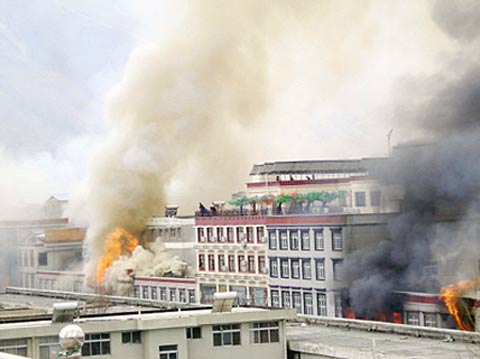
By Serge Piroux and Henri Lederhandler
Tibet has fascinated the world for centuries and inspired many romantic myths and legends. The remote mountainous region and the exotic character of Tibetan Buddhism have stirred the western imagination. [Full coverage]
But pre-1949 Tibet was not the imagined paradise of people living a simple, happy life going about their religious activities. Society was in the grip of a type of feudal serfdom under which politics was intertwined with religion. Temples obstructed all reform; nobles ruthlessly defended their privileges and constantly intrigued against each other. In the old Tibet, serfs were traded and exchanged like pack animals. They were regarded as "horses that can talk", not human beings.
Today the Dalai Lama is seen as a kind, attractive person; a Nobel Peace Prize laureate. But until 1949, the Dalai Lama was the speaker and representative of Tibet's feudal system.
Under feudalism, temples and sutra schools forced families with two boys to send one of them to become a monk. Until 1951, 95 percent of Tibetans were illiterate.
The relationship between Tibetan Buddhism and the emperors of ancient China dates back to the 12th century Yuan Dynasty. The relationship between Tibet and China was like that between "religious leaders and their non-religious protectors." The Dalai Lama and the Panchen Lama had the status of religious counselors to the emperor who in turn was the protector of all lamas and the whole Tibet. The emperor provided material and military support to the lamas, just as to his other subjects. The records show the Dalai Lama was always a vassal of the emperor.
From 1720 to 1910, Tibet was incorporated into the Manchu empire (Qing Dynasty).
In the 19th century, Britain and Russia began to compete and intrigue against each other for control of Tibet. In 1906, Britain recognized China's "suzerainty" over Tibet. It reaffirmed this position in 1912.
The four languages, Han Chinese, Mongolian, Manchu and Tibetan can be found on most royal buildings of ancient China, more evidence that China has continuously exercised sovereignty over Tibet.
In 1950, not long after they had driven out the Japanese invaders and liberated most of the nation, the People's Liberation Army entered Lhasa. Since then major reforms have been carried out in Tibet, the most important being the abolition of the feudal serf system. Hundreds of thousands of serfs were liberated and became "human."
The Central Government held talks in Beijing with the local rulers of Tibet. The Dalai Lama attended the talks and reached several agreements that gave a large measure of autonomy to the temples and the nobles.
But some senior monks and nobles fearing they would lose their privileges, staged uprisings in 1956 and 1959. The Dalai Lama later admitted that the United States Central Intelligence Agency provided financial aid and arms to the insurgents. After the 1959 uprising failed, the Dalai Lama, together with other monks, fled to Dharamsala, India. During the Cultural Revolution (1966 to 1976), in Tibet like in other parts of China, Red Guards destroyed temples and persecuted lamas and nuns. It was the darkest page in the history of modern China. But starting from the 1980s, the Central Government and local authorities did their best to repair the damage. Temples were restored to their original condition. Monks and nuns returned to religious sites.
In the reform and opening up period, Tibet's tourism industry has flourished. A new railway has been built to link this once isolated place to the rest of the country. Shops are filled with merchandise from all over the country. The government provides free medical care for all Tibetans and the average life span and health level of the people have improved greatly. The Central Government has allocated large amount of funds to help Tibet modernize and integrate with the national economy.
Tibet has paid great attention to environmental protection. Nature reserves have been established and renewable energy sources promoted in the region. According to every economic indicator people's lives have improved greatly.
Like other places in China, Tibet faces economic and cultural problems that need urgent solutions. But, according to the International Monetary Fund (IMF) and World Bank (WB), "China has solved the problem of food and clothing for 350 millions people in 20 years." This figure includes millions of Tibetans.
Tibet is one of the most strategically sensitive places in the world. Tibet is the source of Asia's great rivers, the Ganges, Brahmaputra, the Yellow, the Yangtze and the Mekong. It overflows with mineral resources such as uranium, bauxite, copper and lithium and is also rich in petroleum and natural gas.
Tibet is a target that different interest groups would compete and die for.
The March 14 riots in Lhasa and associated protests in other countries were instigated and masterminded by the Dalai clique. Although those taking part were few in number, the western media exaggerated and sensationalized the events, threatening the stability of the region. This is unacceptable.
It is also unacceptable that reporters, commentators and other self-proclaimed judges lecture China on how to deal with the crisis. Many western people have already have misgivings about China. It does nobody any good to encourage further misunderstanding.
About the authors: Serge Pairoux, Secretary-General of the Belgium-China Cultural Center. Henri Lederhandler, Vice Chairman of the Belgium-China Economic and Commercial Council.
(China.org.cn March 31, 2008)